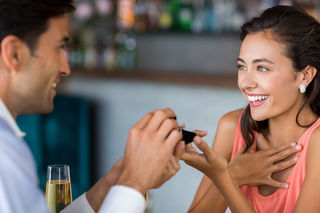Marriage
What Is the Best Way to Propose?
The way you propose speaks volumes.
Posted September 18, 2018

If you're thinking about marriage, and you're ready to propose, what's the best way to go about it? Do you propose in front of friends and family or alone to your partner? Do you make it an elaborate affair or a quiet moment?
Director Glenn Weiss took the "public proposal" approach in a surprising, beautiful moment at the 2018 Emmys, in which he used his acceptance speech to propose to Jan Svendsen. With ring in hand, he announced to hundreds in the room and millions watching on live TV that he had found "the sunshine" in his life, and when she arrived by his side, he got down on one knee and asked, "Will you marry me?"
Rarely are so many people invited to share in the moment a couple becomes engaged. Yet, Americans are quick to recognize the ritual of a marriage proposal. Indeed, at the Emmys, the markers of a proposal occurring were observed by the crowd before Weiss actually popped the question, such as the audience's wild excitement, the gasps, the cheers, and the standing ovation. All of this prompted Weiss to say, "I haven't even asked yet!"
So does how you "pop the question" matter? Researchers recognize marriage proposals as one rite of passage that couples experience as they move from strangers to a committed, married couple in American culture (e.g., Schweingruber, Anahita, & Berns, 2004). As a ritual, proposals involve emotions and bear significant meaning; they are affected by power norms, and within heterosexual couples, they are also tied to gendered roles and expectations. Because of its status as a ritual, how a proposal is executed has emotional significance for each individual, for their identity as a couple, and for their broader social network.
Research suggests that proposals are often performances, designed to show friends and family that a couple is going to get married (Schweingruber et al., 2004). In other words, a couple may have had clear discussions about their marriage plans, but they treat the proposal as a necessary formality that provides a clear signal to others that the couple will wed. Even when the proposal is a surprise, it typically occurs when the couple has either explicitly or implicitly communicated a shared desire for a future together.
Proposals often include traditional elements. Following the cultural "script" of a proposal appears important not only for the people becoming engaged, but for others, like friends and family. One study showed that observers believe individuals are in a stronger relationship when their proposal takes a traditional, versus a non-traditional, approach (Schweingruber, Cast, & Anahita, 2008). Certainly, successful and beautiful marriage proposals can happen in many different ways, but if you do plan to include traditional elements, what does this traditional approach look like?
1. In heterosexual couples, men do the asking. Women sometimes propose, but in general, American couples follow the gender norm of men proposing. In fact, qualitative evidence suggests that when a woman "pops the question," couples often resist making their engagement formal and public until the man "officially" proposes (Schweingruber et al., 2004).
2. An engagement ring is often viewed as an official marker of the engagement. Evidence suggests that when a proposal occurs without a ring, couples often wait until they have a ring before the engagement becomes public knowledge.
3. Surprise! Engagements are typically performed as a surprise, but usually only in the details (e.g., setting, timing). This is perhaps to elicit an authentic emotional response from the person being proposed to, who is expected to have a highly emotional (and positive!) reaction.
4. Down on one knee. In one survey, 85 percent of men proposed down on one knee, an act that serves as a cultural signal that an official marriage proposal is happening (Schweingruber et al., 2004).
5. Adding an element of romance. Perhaps this is the aspect that makes men particularly nervous about proposing, because their partner's expectations about how the proposal might be romantic might not be as clearly understood as a shared desire to become engaged. Evidence suggests that men choose meaningful locations (e.g., where they first met), include flowers, dancing, or sunsets, or propose in creative ways that include a valued object, special skill (e.g., singing), or creative way to deliver the ring (e.g., on a dessert).
Outside of these traditional elements, many men continue to "ask permission" or "ask for a blessing" as part of the proposal (60 percent in Schweingruber's study), a performance designed to elicit endorsement from the woman's family. This again is a gendered norm, one that some people find out of date. Still, many couples report that the act has meaning today, because it shows respect, honors parents who have traditional views on marriage, and lets family be involved in a special moment (Schweingruber et al., 2004).
So should your proposal be public or private? Whether you should propose in public or private appears to be less important than how you construct the proposal. The decision to "go public" with a proposal may reflect your knowledge of your soon-to-be fiance's preferences and personality, your own outgoing tendencies, or a belief that you both, as a couple, would want others to share in the ritual. But what worked for Glenn Weiss isn't everyone's cup of tea. A private proposal could highlight the special moment that you alone are sharing and be most aligned with you and your partner's habits and preferences.
Casual conversations before an engagement could be a helpful way to make sure that you and your partner are in sync regarding the type of proposal you're each hoping for as you prepare for this important relationship ritual.
References
Schweingruber, D., Anahita, S., & Berns, N. (2004). “Popping the question” when the answer is known: The engagement proposal as performance. Sociological Focus, 37(2), 143-161.
Schweingruber, D., Cast, A. D., & Anahita, S. (2008). “A story and a ring”: Audience judgments about engagement proposals. Sex Roles, 58(3-4), 165-178.




